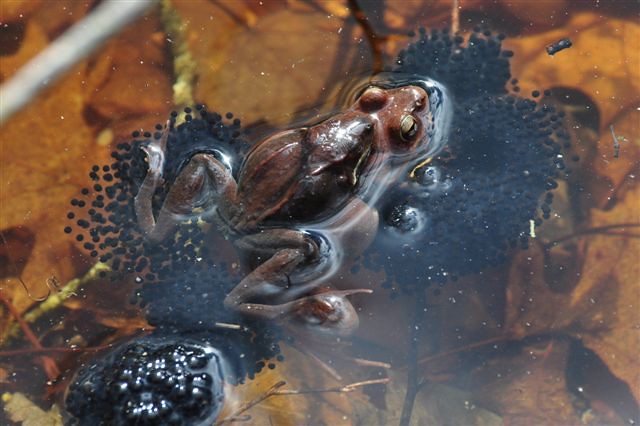Welcome to Creature Feature, a biweekly series from the CELT education team highlighting local wildlife. Each week, we will share a short introduction to a local organism that you might encounter in your backyard or on our trails.
Excitement is in the air as we eagerly await the “Big Night!” The signs are all there: snowmelt, ponds opening up, longer days, and warming temperatures. Any day now, we will hit the perfect combination: a nighttime low temperature in the 40s-50s heavy rainfall, just warm and wet enough for our local amphibians to travel safely to the nearest vernal pool.

The Big Night is when hundreds of thousands of amphibians all over the state make their way out of hibernation and into surrounding vernal pools in order to find a mate and lay eggs. The majority of this miniature migration usually takes place in a single, “big” night when the temperatures and weather are just right. Spring peepers, wood frogs, and spotted salamanders are just a few of the amphibians that participate in the Big Night.
These amphibians lay their eggs in vernal pools, temporary wetlands that have no freshwater source of their own but fill with snowmelt and rainfall in the spring. These pools make great breeding grounds because they do not contain fish, which consume amphibian eggs. Healthy vernal pools are so important to amphibians – as well as the other species that they affect in the ecosystem – that Maine, like most states, has adopted strict laws to make sure they stay protected.

The Big Night has been happening here in New England every year since the glaciers melted. And while we still live with so much uncertainly these days, the Big Night will happen again this year, likely sometime between late March and early April. One good clue is to listen for the spring peepers. Once you hear that unmistakable sound of early spring you can be sure that the Big Night isn’t far behind.
I mentioned earlier that the Big Night occurs on the very first night that temperatures are warm enough and the outdoors is wet enough for the amphibians to make the voyage. This raises a question: if amphibians need the warmth and moisture of spring, how exactly do they survive the winter?
Both amphibians and reptiles are cold-blooded, meaning that they cannot regulate their own body temperature. Instead, their body temperature is dependent on the water or air they are living in. This is why you often see turtles sunning themselves on logs, or snakes sunning themselves on a warm rock. This is also why these creatures tend to be slow and sluggish in the early morning when they have not yet warmed up yet from the cooler night temperatures.
Both reptiles and amphibians have amazing adaptations for surviving a cold Maine winter. Snakes, which are reptiles, find a cave or den and go into a state of brumation where they slow their metabolism and conserve energy by limiting their movement. Turtles and toads hibernate in a manner similar to that of snakes, digging their way down beneath the leaf litter, under logs, or below the bottom of a pond. They also slow their metabolism to conserve energy, which is the key to survival.
Frogs such as the spring peeper and wood frog have some extraordinary methods for making it through the winter. Neither of these species of frog are good at burrowing into the ground. If they don’t make it deep enough below the frost line, their bodies will freeze solid and their hearts will stop beating. To the naked eye, these frogs appear completely frozen. Yet, on a microscopic level the internal organs are filled with a high concentration of glucose, which serves as a sort of antifreeze and also provides essential nourishment the frogs’ cells. Incredibly, this adaptation allows the frogs to survive the winter and awaken when warm weathers help thaw them out in the spring.

Believe it or not, amphibians make up a large portion of our the forest ecosystems. Several studies have shown that the biomass of amphibians in a Maine forest ecosystem is greater than the combined biomass of mammals and birds in that same area. This means if you could collect every amphibian in a certain area of the forest along with every bird and mammal, there would be more amphibians (by weight) than the other two combined!
Sadly, amphibians are among the most vulnerable species in forest ecosystems. Even with the protections placed on vernal pools, other nearby development has created new dangers. Today, paved roads often separate amphibians from their nearest vernal pools, requiring a dangerous crossing that can lead to increased mortality. In recent years many groups have come together to help this vulnerable population, by creating tunnels under roadways for safe passage and even keeping watch through the night to help individuals cross and encourage cars to slow down. In fact, most of what we know about Big Night comes from the work of local and citizen scientists who make their way out in the rain to observe (and sometimes protect) amphibians crossing roads to get to their mating grounds.
If you want to help or learn more about the Big Night here in Maine check out these links:
- https://www.vernalpools.me/big-night/ This is a really good one if you want to get involved!
- http://www.vernalpools.me/wp-content/uploads/2015/05/vernalpoolecology.pdf
- https://www.facebook.com/groups/bignightmaine/
—BY LISA GENT, CELT EDUCATION COMMITTEE CHAIR
